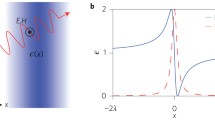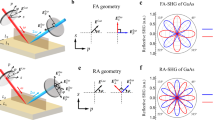Abstract
We give an interface between two same media whose orientation of optical axis, however, is rotated, and describe a method in detail to show how to calculate reflectance coefficient in this interface. We also give the theoretical simulation of the reflectance coefficient and discuss the effect of the rotation angle and the direction of electron vector on the reflectance coefficient. For the un-polarized lights the theoretical calculated results show that the reflectance coefficients (r x1 and r y1) are very small when the rotated angle is small, and they arrive at the maximum value as the rotation angle is equal to a decided value. For the polarized light, when the rotation angle is small, the reflectance coefficients (r x1 and r y1) are also small. Only when the rotation angle increases to a certain extent, they can reach the maximum values and be strongly affected by the direction of electronic vector. However, this effect on the reflectance coefficient in the direction of the maximum refraction is different from that in the direction of minimum refraction.
Similar content being viewed by others
References
Holmes D A, Feucht D L. Electromagnetic wave propagation in briefringent multi-layers. J Opt Soc Am, 1966, 56(12): 1763–1769
Schesser J, Eichmann G. Propagation of plane waves in biaxially anisotropic layered media. J Opt Soc Am, 1972, 62(6): 782–791
Abdulhalim I. Exact 2 × 2 matrix method for the transmission and reflection at the interface between two arbitrarily oriented biaxial crystals. J Opt A, 1999, 1: 655–661
Abdulhalim I. 2×2 matrix summation method for multiple reflections and transmissions in a biaxial slab between two anisotropic media. Opt Commun, 1999, 163: 9–14
Yeh P. Electromagnetic propagation in briefringent layered media. J Opt Soc Am, 1979, 69(5): 742–755
Yeh P. Optics of anisotropic layered media: A new 4×4 matrix algebra. Surf Sci, 1980, 96(1–3): 41–53
Chen J Y, Chen L W. Twist defect in chiral photonic structures with spatially varying pitch. J Phys D: Appl Phys, 2005, 38: 1118–1126
A Lien. Extended Jones matrix representation for the twisted nematic liquid-crystal display at oblique incidence. Appl Phys Lett, 1990, 57(26): 2767–2769
Li S F, Chen J Y, Chen L W. Jones-matrix analysis with Pauli matrices application to ellipsometry. J Opt Soc Am, 2000, 17: 5
Lakhtakia A, Weiglhofer W S. A comparative study of planewave propagation in helicoidal bianisotropic mediums and isotropic chiral mediums. J Opt A: Pure Appl Opt, 2000, 2: 107–111
Author information
Authors and Affiliations
Corresponding author
Rights and permissions
About this article
Cite this article
Feng, S., Chen, T. & Xie, J. Self-consistent method for calculation of reflection coefficients of the interface with the dielectric tensor’s rotation. Sci. China Ser. G-Phys. Mech. Astron. 51, 797–804 (2008). https://doi.org/10.1007/s11433-008-0082-x
Received:
Accepted:
Published:
Issue Date:
DOI: https://doi.org/10.1007/s11433-008-0082-x




